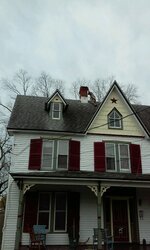Installed the 30ft liner and ran the NC30 a couple of nights so far. Straddling my roof top >30ft in the air was downright frightening lol. The top plate is too small for the chimney so I just angled it onto the chimney top. I'm going to wait a while until I rent a bucket lift to install it properly. I may have to cut a hole in a sheet metal piece, secure the sheet metal to the chimney with a circle cut out of it for the liner and secure the top plate onto the sheet metal.
The NC30 is a heat throwing beast! Pretty easy to operate so far. There's usually a nice coal bed so I rake them to the front, drop the biggest pieces E/W in the rear, and load it up. I shut down the primary air all the way when the stove top hits about 450-500 degrees. Massive secondary burn ensues. With the secondaries going the stove top will easily hit 750 or so. I've seen 800+ temps a few times as well. The draft seems way too strong. There's no lazy flames even with the primary control pushed in all the way.
Do I need a flue pipe damper? Or, should I just permanently obstruct the rear air inlet (partially of course)? If I do the damper on the flue pipe, it will have to be right on the flue collar or it will be extremely hard to reach. I'll have to use a stove pipe with a mild angle to permanently complete the setup.
The NC30 is a heat throwing beast! Pretty easy to operate so far. There's usually a nice coal bed so I rake them to the front, drop the biggest pieces E/W in the rear, and load it up. I shut down the primary air all the way when the stove top hits about 450-500 degrees. Massive secondary burn ensues. With the secondaries going the stove top will easily hit 750 or so. I've seen 800+ temps a few times as well. The draft seems way too strong. There's no lazy flames even with the primary control pushed in all the way.
Do I need a flue pipe damper? Or, should I just permanently obstruct the rear air inlet (partially of course)? If I do the damper on the flue pipe, it will have to be right on the flue collar or it will be extremely hard to reach. I'll have to use a stove pipe with a mild angle to permanently complete the setup.






